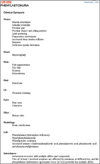Inherited disorder phenotypes: controlled annotation and statistical analysis for knowledge mining from gene lists
- PMID: 16351744
- PMCID: PMC1866390
- DOI: 10.1186/1471-2105-6-S4-S18
Inherited disorder phenotypes: controlled annotation and statistical analysis for knowledge mining from gene lists
Abstract
Background: Analysis of inherited diseases and their associated phenotypes is of great importance to gain knowledge of underlying genetic interactions and could ultimately give clinically useful insights into disease processes, including complex diseases influenced by multiple genetic loci. Nevertheless, to date few computational contributions have been proposed for this purpose, mainly due to lack of controlled clinical information easily accessible and structured for computational genome-wise analyses. To allow performing phenotype analyses of inherited disorder related genes we implemented new original modules within GFINDer http://www.bioinformatics.polimi.it/GFINDer/, a Web system we previously developed that dynamically aggregates functional annotations of user uploaded gene lists and allows performing their statistical analysis and mining.
Results: New GFINDer modules allow annotating large numbers of user classified biomolecular sequence identifiers with morbidity and clinical information, classifying them according to genetic disease phenotypes and their locations of occurrence, and statistically analyzing the obtained classifications. To achieve this we exploited, normalized and structured the information present in textual form in the Clinical Synopsis sections of the Online Mendelian Inheritance in Man (OMIM) databank. Such valuable information delineates numerous signs and symptoms accompanying many genetic diseases and it is divided into phenotype location categories, either by organ system or type of finding.
Conclusion: Supporting phenotype analyses of inherited diseases and biomolecular functional evaluations, GFINDer facilitates a genomic approach to the understanding of fundamental biological processes and complex cellular mechanisms underlying patho-physiological phenotypes.
Figures



References
-
- Phillips TJ, Belknap JK. Complex-trait genetics: emergence of multivariate strategies. Nat Rev Neurosci. 2002;3:478–485. - PubMed
Publication types
MeSH terms
LinkOut - more resources
Full Text Sources
Medical

